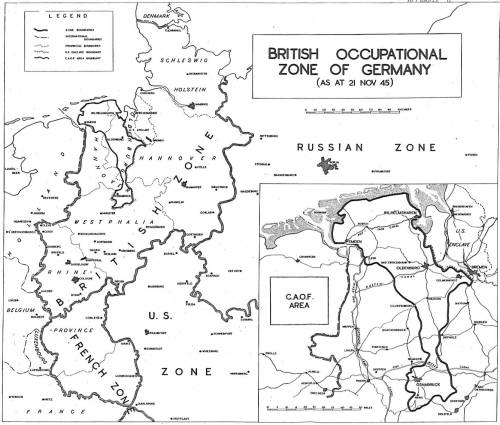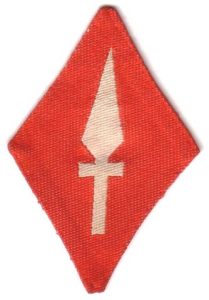
Unknown to many, the British Army of the Rhine was first established as an occupational force after the Great War of 1914 – 1918. It then went on to be disbanded in 1929. Little did people know that only 15 years later it would be back firmly in position.
The second coming came about with the creation of Twenty-first Army Group, assigned with the invasion of Europe. Formed in September 1943 in England and commanded by General (later Field Marshal) Sir Bernard Montgomery, it initially controlled all ground forces in Operation Overlord. When sufficient American forces had landed, their own 12th Army Group was activated, under General Omar Bradley and 21st Army Group was left with British Second Army and First Canadian Army.
After the successful Normandy landings, the units of 21st Army Group crossed the river Rhine near the Germany city of Wesel on 23 March 1945. After an advance which was thoroughly resisted, the British formations, along with the Canadians and Americans advanced into the German counties of Nordrhein-Westfalen, Niedersachsen and Schleswig-Holstein . This established the British Army occupying the north of the country.
At the February 1945 Yalta Conference (and confirmed at the July 1945 Potsdam Conference) it was agreed that it should be divided into four with the addition of a small French Zone (adjacent to the Franco-German border). Similar arragements were agreed for Austria and the City of Berlin which was otherwise deep in East Germany (Russian Zone of Occupation). The earlier arrangement for the transfer of East Prussia and the move of the eastern border to the Oder Neisse Line remained unaltered.
The map above shows the revised Zones, you will see that in addition to the new French Zone, the border of the British/American Zone has been moved north and a small American enclave round the River Weser including the Bremen Docks (which formed the ocean going terminal for military traffic from America).
Three months after the war had ended, 21st Army Group was redesignated “British Army of the Rhine”. This occupational force, which gained its new title on 25 August 1945 consisted of 80,000 men and consisted of the following:

1st Corps District
8th Corps District
30th Corps District
British Troops Berlin
Click here to view the History of 1 (BR) Corps
The British Army of the Rhine with the HQ in Bad Oeynhausen consisted of
Guards Division
7th Armoured Division
11th Armoured Division
79th Armoured Division
3rd Infantry Division
5th Infantry Division
15th (Scottish) Infantry Division
49th (West Riding)) Infantry Division
51st (Highland) Infantry Division
52nd (Lowland) Infantry Division
53rd (Welsh) Infantry Division
1st Polish Armoured Division
3rd Canadian Infantry Division CAOF with British Troops under command
Click here for further information May 1945 to Feb 1949
In 1947-48 reduced to three divisions and districts
2nd Infantry Division
5th Infantry Division – disbanded Jan 1948
7th Armoured Division – disbanded Feb 1948
Hamburg District
Hannover District
British Troops Berlin
The formation of NATO in 1949 had the BAOR as the British land force contribution. In September 1950 saw 11th Armoured Division reformed on German soil. 1st (BR) Corps was also reformed a year later, after its disbandment in 1947. 1951 saw the recreation of 6th Armoured Division in Great Britain, with it being moved to Germany in 1952. At this point the BAOR consisted of the following:
Click here for information from Mar 1949 onwards
1st (BR) Corps
6th Armoured Division
7th Armoured Division
11th Armoured Division
2nd Infantry Division
British Troops Berlin
Rhine Army Troops
Hamburg District
Hannover District
Rhine District
5 Army Group Royal Artillery (Anti-Aircraft)
School of Artillery, BAOR
Engineer Training Establishment, BAOR
RAC Training Establishment, BAOR
Rhine Army All Arms Training Centre
Aquatic Training School, BAOR
On 29 November 1952, the Headquarters of Northern Army Group (NORTHAG) formed. This NATO creation saw the BAOR being placed under its command. The ceased to by an occupation force and became responsible for the northern front from Hamburg to Kassel in the event of a Soviet invasion.
During October 1954 HQ BAOR reallocated from Bad Oeynhausen to Rheindalen. Only a month earlier had seen the first large scale NORTHAG exercise, appropriately named, Battle Royal. The BAOR at this point still consisted of 80,000 troops.
1956 Saw more major changes to the BAOR. Brigade groups took over from divisions as the smallest operative units. This was the first major step towards the army of today, with a brigade group comprising of armour, infantry, an engineer squadron and armoured reconnaissance regiment, opposed to divisions comprising solely infantry or armour (the first case of mixed brigades being used effectively was near Soltau, April 1945, by 4th Armoured Brigade, led by Brigadier Carver). Also during this year on 1 April, 11th Armoured Division was reorganised into 4th Infantry Division. This consisted of:
10th Infantry Brigade Group
11th Infantry Brigade Group
12th Infantry Brigade Group
It was decided in 1957 that the British Army defending Europe from the Soviet threat should reduce down to 64,000 (still over three times of what remains today). The following year 7th Armoured Division was given the prefix of 5th and 6th Armoured Division amalgamated with 2 Inf Div who moved from Hilden to Lübeck where the HQ was located in TAX House.
Between 1958 and 1960 National Service came to an end and further reductions in manpower took place. With 55,000 men, the restructuring of the BAOR took shape in the form of three divisions of two armoured brigade groups and five infantry brigade groups.
In June 1960 came the creation of the 1st Armoured Division, formerly 5th Armoured Division. Under its command came 7th and 20th Armoured Brigade Groups.

The shoulder flash of 1 (BR) Corps
Major reorganisation was not far away, as seven brigade groups were reorganised into three central divisions, during 1963. 5th Brigade group returned to Great Britain as strategic reserve, with 1 (BR) Corps (redesignated to distinguish it from other NATO corps) consisting of:
4th Guards Brigade Group
6th Infantry Brigade Group
11th Infantry Brigade Group
12th Infantry Brigade Group
7th Armoured Brigade Group
20th Armoured Brigade Group
In 1965 the organisation of BAOR went full circle again with brigade groups redesignated to brigades. The following year the organisation was as follows:
HQ BAOR (Rheindalen)
1 (BR) Corps (Bielefeld)
1st Division (Verden)
2nd Division (Lübbecke)
4th Division (Herford)
The subordinate brigades were:
4th Guards Infantry Brigade (Iserlohn)
6th Infantry Brigade (Münster)
7th Armoured Brigade (Soltau)
11th Infantry Brigade (Minden)
12th Infantry Brigade (Osnabrück)
20th Armoured Brigade (Detmold)
Berlin Brigade (Berlin)
In 1968 6th Infantry Brigade was relocated back to Great Britain, only to return in the Autumn of 1970. Its new location was in the towns of Iserlohn and Soest, as the previous occupants (The Canadian Brigade) had moved to southern Germany.
By 1973, 1 (BR) Corps consisted of:
1st Division (Verden)
7th Armoured Brigade (Soltau)
11th Infantry Brigade (Minden)
2nd Division (Lübbecke)
4th Guards Infantry Brigade (Münster)
12th Mechanised Brigade (Osnabrück)
4th Division (Herford)
6th Armoured Brigade (Körbecke)
20th Armoured Brigade (Detmold)
1st Artillery Brigade (Hildesheim)
HQ/Signals Battery (Hildesheim)
2 x Heavy Field Artillery Regiments (Hildesheim)
2 x Missile Artillery Regiments (Hildesheim)
7th Air Defence Brigade (Dortmund)
11th Engineer Brigade (Hameln)
With September in 1976 came the creation of the Artillery Division. Headed from Bielefeld it comprised:
5th Heavy Regiment RA (Hildesheim)
50th Missile Regiment, RA (Menden)
12 Air Defence Regiment, RA (Dortmund)
22nd Air Defence Regiment, RA (Soest)
94th Locating Regiment, RA (Celle)
1st Battalion, The Royal Scots, Infantry (Münster)
8th Transport Regiment, RCT (Münster)
More reorganisation was implemented in January 1978 with the creation of 3rd and 4th Armoured Brigades. The divisions were created from 6th (Soest) and 20th (Detmold) Armoured Brigades and the divisional troops of 4th Division. A very armour-orientated BAOR were as follows:
1 (BR) Corps (Bielefeld)
1st Armoured Division (Verden)
2nd Armoured Division (Lübbecke)
3rd Armoured Division (Körbecke)
4th Armoured Division (Herford)
5th Field Force (Osnabrück)
Artillery Division (Bielefeld)
Each of the above regiments were also bolstered by an Army Air Corps Regiment. Each regiment shared the same prefix as the armoured divisions, with the exception of 9th Regiment, Army Air Corps which served at Corps level.
Eventually all good things must come to an end and so it did with 1 British Corps being disbanded and replaced by Allied Command Europe Rapid Reaction Corps (ARRC), which is part of the North Atlantic Treaty Organisation (NATO). This development in 1992 and the “Options for Change” redundancy package were a sign of things to come now that the “Russian hordes” were no longer seen to be the main threat.
Now in 2007 further reductions look to be in place with the proposed closure of Münster, Osnabruck, Celle and JHQ. What good has come from it is that this has given longer life to the likes of Fallingbostel/Hohne, Paderborn/Sennelager and Bielefeld/Gütersloh/Herford. Time will tell.
Sourced from; BLUME P. (2006) Vehicles of the British Army of the Rhine, Tankograd – British Special No. 9003: Erlangen, Germany.
